On Monday, August 6th, a group from the Centro de Estudios Borjanos (CESBOR), an institution dedicated to research and support of the history and culture of the small town of Borja, outside Zaragoza in the autonomous region of Aragon, northeastern Spain, visited a local church to examine the condition of a certain fresco. The painting on the wall of the church of the Sanctuary of Mercy was the only work in town done by turn of the century artist Elías García Martínez and one of his granddaughters had just donated money to restore it.
The fresco, a 20-by-15-inch portrait of Christ wearing the crown of thorns called Ecce Homo, was in poor condition. Water leaks and salt damage left the paint flaking off so that in the past 10 years it had gone from looking like this:
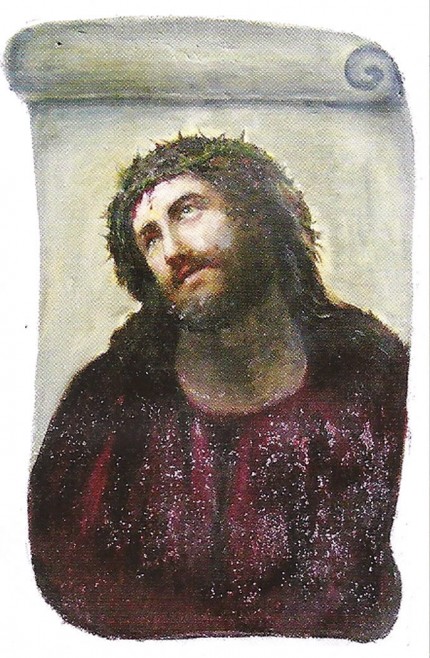
To looking like this two months ago:
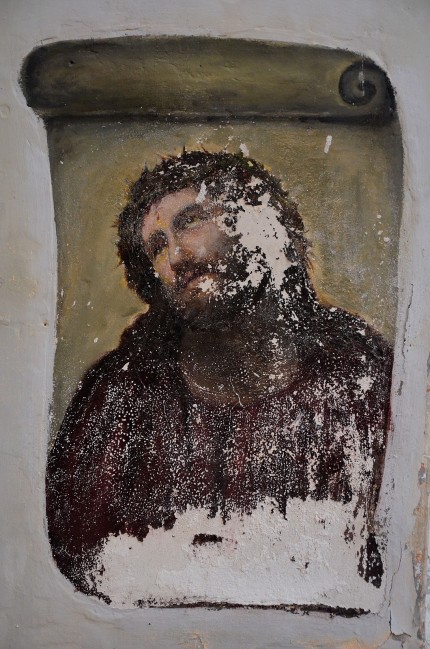
When they arrived at the church, however, they were horrified to find it looking like this:

In a plaintive blog entry about the discovery, the CESBOR folks deplored the mutilation of the work of art. They had no idea who had perpetrated the vile act, but the initial assumption was that it was a work of vandalism done in secret which they denounced in no uncertain terms. The blog entry noted that the Martínez family had met with the mayor to lodge a complaint and that the possibility of legal action was not excluded.
This week the story made the Spanish press (the El Pais article has an entertaining dragable before and after graphic), then it made the Internet and news outlets all over the world.
As “Ecce Mono” (“Behold the Monkey”) went viral, the culprit stepped forward. It was no malicious vandal, but rather an 81-year-old church volunteer named Cecilia Giménez, an amateur artist who had done touch-ups on the painting several times over the years. In an interview with Spanish television (clips from that story are in this BBC video translated into English), she claimed there was no secret about it at all. She did it with the advanced knowledge and permission of the priest and in full view of anybody who walked into the church as she worked. The church has no money so volunteers are always fixing things and this was no different.
She’s an accomplished artist, she insisted, who once had a four-room exhibition of her work from which she sold 40 paintings. Something just went wrong this time. She doesn’t know why, but it just got out of hand. When she realized she was in way over her head, she reported her work to the town councilor for culture, Juan Maria de Ojeda. She loved the painting and just wanted to help.
The city council is still considering taking some kind of legal action against her because her good intentions notwithstanding, her unsolicited intervention was “an assault on artistic patrimony.” I seriously doubt they’ll take it to the law. She’s an elderly church booster who is the sole caretaker of her disabled 60-year-old son. The diocese also thinks the reaction has been exaggerated since little old ladies are always doing stuff like this in churches out of devotion and nobody gets too wound up about the quality of their work.
City officials are bringing in professional restorers Monday to see if Cecilia Giménez’s “restoration” can be undone. Prospects are grim. The original work is a hundred years old and it was done directly on the unprepped wall with oil paints. There’s a reason frescoes are made with pigment applied to wet plaster; oil on wall tends to flake right off.
 If it can’t be re-restored, that might be a boon for the city. “The world’s worst restoration” has a growing fan club now. It has become a major tourist attraction and subject of a Change.org petition to keep the new version rather than allow restorers to revert it back to the original. As the petition puts it:
If it can’t be re-restored, that might be a boon for the city. “The world’s worst restoration” has a growing fan club now. It has become a major tourist attraction and subject of a Change.org petition to keep the new version rather than allow restorers to revert it back to the original. As the petition puts it:
The daring work of the spontaneous artist in the Ecce Homo of the Sanctuary of Mercy of Borja is an endearing and a loving act, a clever reflection of political and social situation of our time. It reveals a subtle critique of creationist theories of the Church, as well as questioning the emergence of new idols. The result of the intervention cleverly combines primitive expressionism Francisco de Goya, with figures such as Ensor, Munch, Modigliani or Die Brücke group of German Expressionism.
Also the Monchichi school of Sekiguchi Corporation and Hanna-Barbera.
Anyway it’s not like the original is a masterpiece, despite what some of the more sensationalistic headlines said when the story first broke. It has more sentimental value than artistic or historical significance. Elias Garcia Martinez was a fairly well-known local painter of traditional-style popular works in the late 19th and early 20th century. He was a professor at the Fine Arts School of Zaragoza from 1894 until his retirement in 1929, and he and his family used to vacation in Borja during the summer break. One of those summers he spent two hours painting Christ with a crown of thorns on a church wall in honor of the Virgin of Mercy.
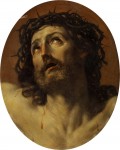 It wasn’t even a work born from the fires of his imagination. He copied it from a mass-production print, etching, maybe a porcelain plate or one of those prayer cards with cheesy pictures of saints. The true original was Baroque master Guido Reni who around 1630 made an oil on copper panel painting called Head of Christ Crowned with Thorns, now in the Detroit Institute of Arts. He made several other similar pieces (here’s one in the Louvre), and by the time Martinez was painting, versions of Reni’s roll-eyed Christ — now modestly attired in bulky tunics — were ubiquitous.
It wasn’t even a work born from the fires of his imagination. He copied it from a mass-production print, etching, maybe a porcelain plate or one of those prayer cards with cheesy pictures of saints. The true original was Baroque master Guido Reni who around 1630 made an oil on copper panel painting called Head of Christ Crowned with Thorns, now in the Detroit Institute of Arts. He made several other similar pieces (here’s one in the Louvre), and by the time Martinez was painting, versions of Reni’s roll-eyed Christ — now modestly attired in bulky tunics — were ubiquitous.
Martinez’s version isn’t even all that great of a copy, in my opinion. The chromolithograph and porcelain plate below are much better. Their illustrators probably took longer than two hours to make them.
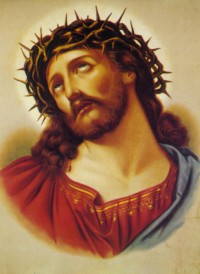
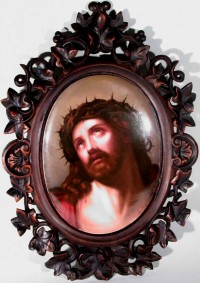
And now for my own composition. I call it The Devolution of Christ.
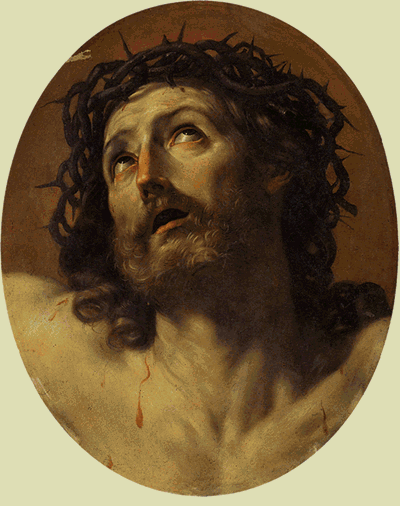
😆 crying laughing
Admit it: you want to have your picture taken in front of the Jesus Monkey too. :giggle:
The original expression looked stoned, so maybe this could be done as an anti-drug PSA?
Oh like a “this is your Jesus on drugs” thing? That could work.
I was just making a new thread about this story on ff. When I used a Google image search to find some ‘before’ and ‘after’ photos to link to, the first one I clicked on took me to thehistoryblog.com :giggle:
Scooped again!
Yay! I love scooping you! (Or anyone else, for that matter.) :boogie:
Not that you can’t still make a thread about it, mind you. I was scooped by Reddit and Gawker but that didn’t stop me from doing my thing.
I firmly believe the Hanna-Barbera Jesus is directly descended from a Grape Ape.
Maybe a century from now someone will blunder its resporation and create and even weirder version. I wish I could see that.
Brilliant comment, after all the nonsense we’ve been seeing these past few days. Thanks.
Nobody ever reckons with the Spanish Inquisition. Praise the Lord that she did not paint that other prophet. I mean, this ain’t no turban for sure. No masterpiece got harmed, so sing along:
I saw the light, I saw the light.
No more darkness, no more night.
Now I’m so happy, no sorrow in sight,
Praise the Lord, I saw the light.
I wandered so aimless, life filled with sin
As I wouldn’t let my dear Savior in
And Jesus came like a stranger in the night
Praise the Lord I saw the light.
Good Vibes from Addis
I really thing she captured the agony of Christ in his final march to the cross. I certainly feel pain. Deep, terrible pain.
I’m on the fence about restoring the original. If I had my way I’d keep both in a side by side comparison.
It’s almost three days since I first read this story and I’m Still chuckling. 😆
If that woman hadn’t stepped forward and taken responsibility, I would have suggested that the culprit might be Mr. Bean.
Help me Jebus….
I can NOT stop laughing….
http://i3.minus.com/ibtUIkxesROkTt.jpg 😀
:notworthy:
:skull:
I have one from 1909 painted in silk material,i want to know the value,thank you…
I think its the work of a Darwin believer and is depiction of Jesus as the missing link.